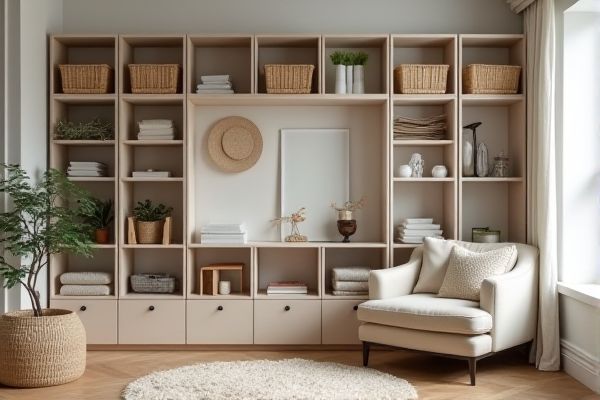
Woven cubbies offer a natural, breathable storage solution that adds a warm, aesthetic touch to any room, while plastic cubbies provide durability, easy cleaning, and resistance to moisture, making them ideal for heavy use or damp environments. Explore the full article to determine which cubby option best suits your storage needs and style preferences.
Table of Comparison
| Feature | Woven Cubbies | Plastic Cubbies |
|---|---|---|
| Material | Natural fibers (rattan, wicker, seagrass) | Durable plastic (polypropylene, polyethylene) |
| Durability | Moderate; prone to fraying or damage with heavy use | High; resistant to impact, moisture, and stains |
| Weight | Lightweight and easy to move | Generally lightweight but can vary by design |
| Maintenance | Requires gentle cleaning; avoid moisture exposure | Easy to clean with water and mild detergent |
| Appearance | Natural, warm, and textured look | Available in various colors and sleek finishes |
| Environmental Impact | Eco-friendly, biodegradable materials | Non-biodegradable; recyclable depending on plastic type |
| Cost | Typically moderate to high | Wide range; often more affordable options |
| Best Use | Decorative storage, light items, living and office spaces | Heavy-duty storage, kids' rooms, garages, bathrooms |
Introduction to Woven and Plastic Cubbies
Woven cubbies are crafted from natural or synthetic fibers, offering a breathable and eco-friendly storage solution ideal for organizing household items with a textured, stylish appearance. Plastic cubbies, made from durable polymers, provide waterproof, easy-to-clean compartments suited for environments prone to moisture, such as bathrooms or garages. Both options vary in weight capacity and design versatility, making them suitable for different organizational needs and aesthetic preferences.
Material Composition and Durability
Woven cubbies are typically made from natural fibers such as cotton, jute, or seagrass, offering a flexible, breathable structure that is lightweight but can wear down over time with heavy use. Plastic cubbies utilize synthetic materials like polypropylene or polyethylene, known for their durability, resistance to moisture, and ease of cleaning, making them ideal for long-term storage solutions. The choice between woven and plastic cubbies depends on the need for aesthetic appeal and softness versus sturdiness and maintenance convenience.
Aesthetic Appeal and Design Options
Woven cubbies offer a warm, natural aesthetic with intricate patterns that enhance any room's decor, providing a stylish and textured element to your storage solutions. Plastic cubbies come in a wide range of colors and sleek finishes, allowing for versatile and modern design options that can easily match various interior styles. Your choice depends on whether you prefer the organic charm of woven materials or the vibrant, customizable appeal of plastic cubbies.
Eco-Friendliness and Sustainability
Woven cubbies are crafted from natural fibers such as seagrass, rattan, or cotton, making them biodegradable and renewable, significantly reducing environmental impact compared to plastic cubbies. Plastic cubbies, often made from non-biodegradable materials like polypropylene or PVC, contribute to landfill waste and microplastic pollution, posing sustainability challenges. Choosing woven cubbies supports eco-friendly practices by utilizing sustainable resources and promoting product lifecycle circularity.
Storage Capacity and Flexibility
Woven cubbies offer flexible storage solutions with breathable materials that easily adapt to various items, enhancing organization without rigid dividers. Plastic cubbies provide structured compartments with higher durability and water resistance, maximizing storage capacity for heavier or moisture-prone items. Your choice depends on whether you prioritize adaptable storage or sturdy, moisture-resistant compartments.
Ease of Cleaning and Maintenance
Woven cubbies, typically made from natural fibers, can be more challenging to clean due to their porous texture that traps dust and spills, requiring gentle spot cleaning and occasional vacuuming to maintain appearance. Plastic cubbies offer superior ease of cleaning as their smooth, non-porous surfaces allow for quick wiping with a damp cloth and disinfectants, making them ideal for environments needing frequent sanitation. Maintenance of plastic cubbies is generally minimal with high resistance to stains and moisture, while woven cubbies may require more careful upkeep to prevent fraying and mold growth in humid conditions.
Safety Features for Home and School Use
Woven cubbies offer a softer, non-toxic storage option with breathable materials that reduce the risk of injury, making them ideal for homes and schools where children frequently access belongings. Plastic cubbies, while durable and easy to clean, often contain sharp edges and hard surfaces that may pose safety concerns without proper design and maintenance. Incorporating rounded corners and BPA-free plastics with secure lids enhances plastic cubbies' safety for educational and residential environments focused on child protection.
Cost Comparison and Value for Money
Woven cubbies typically cost more upfront than plastic cubbies due to their handcrafted materials and design, but they offer greater durability and aesthetic appeal, making them a long-term investment. Plastic cubbies are often more affordable and lightweight, providing a budget-friendly option for temporary or casual storage needs. Evaluating value for money depends on the intended use, with woven cubbies excelling in style and longevity while plastic cubbies offer cost-effective practicality.
Best Uses for Woven vs Plastic Cubbies
Woven cubbies are ideal for storing lightweight items such as clothing, toys, and linens, offering a breathable and aesthetically pleasing option for bedroom or living room organization. Plastic cubbies excel in environments that require durability and moisture resistance, like bathrooms, garages, or playrooms, where easy cleaning and sturdiness are essential. Selecting woven cubbies supports decorative storage needs, while plastic cubbies are better suited for practical, rugged use cases.
Final Verdict: Choosing the Right Cubbies for Your Needs
Woven cubbies offer a stylish, breathable storage solution ideal for lightweight or decorative items, enhancing room aesthetics with natural textures. Plastic cubbies provide durable, moisture-resistant compartments perfect for heavy-duty use, easy cleaning, and organizing toys or craft supplies. Selecting the right cubbies depends on balancing style preferences, durability requirements, and the type of items to be stored in your space.
 homyna.com
homyna.com